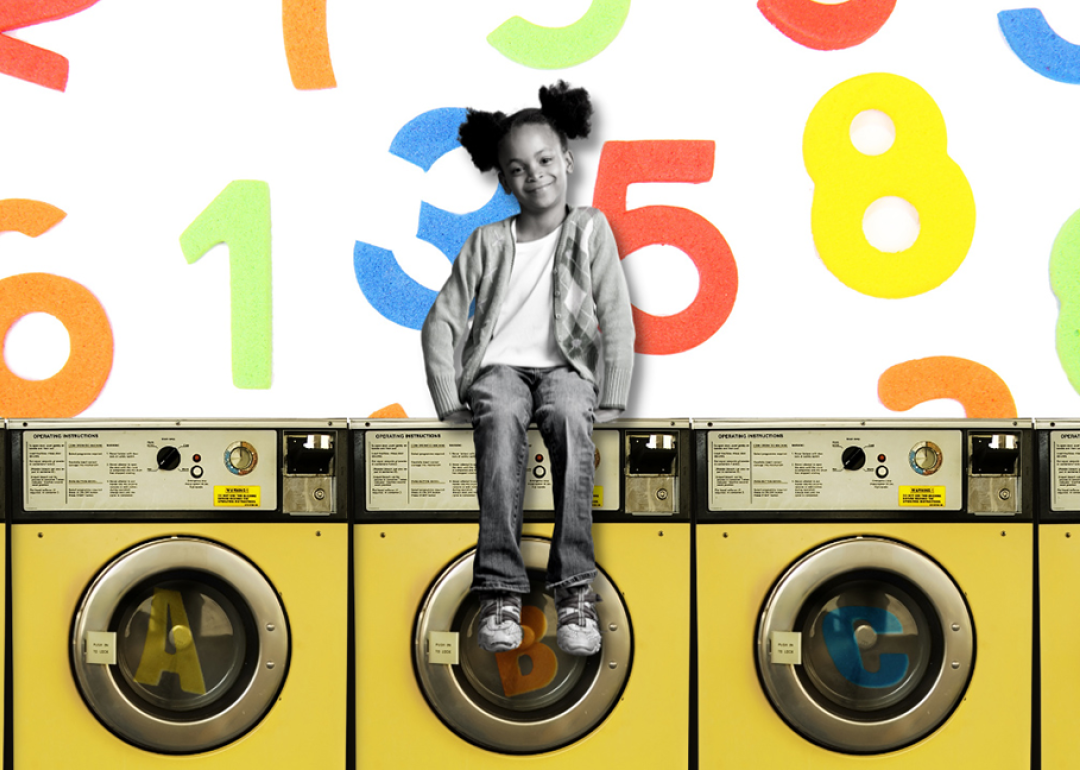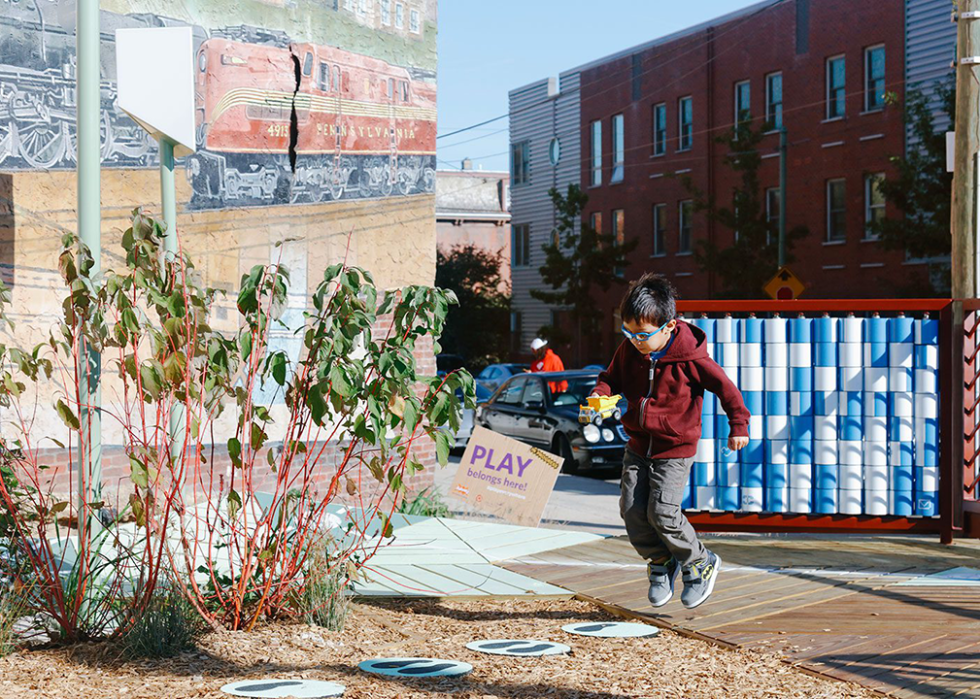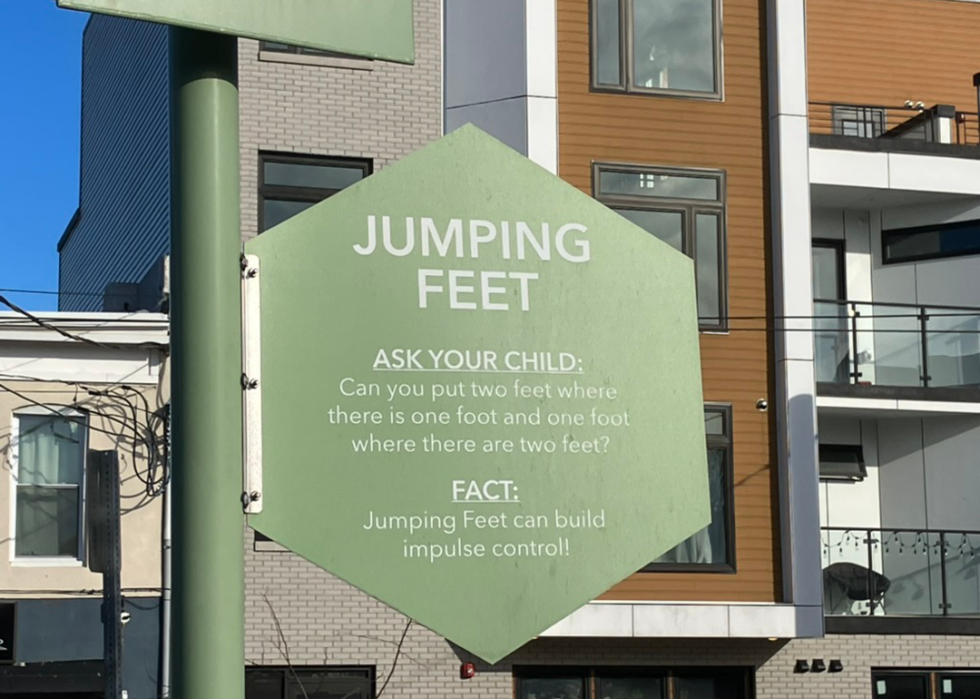
From bus stops to laundromats, cities embrace play to help kids learn
This story was produced by The 74 and reviewed and distributed by Stacker Media.
From bus stops to laundromats, cities embrace play to help kids learn
On a tiny triangular lot in Philadelphia's Belmont neighborhood, kids waiting with their parents for the No. 40 bus can also work on their executive functioning skills, playing a hopscotch variation designed to train their brains.
In Chicago, a wooden game mounted on the wall of a laundromat teaches children, in two languages, how to find color patterns in a lineup of detergent bottle tops.
And in Santa Ana, Calif., a basketball court doubles as a giant, real-time fractions lesson.
These are three examples of an unusual model of on-the-fly learning mixed with urban design, one that has emerged from decades of research on the role of play in kids' lives.
The installations, overseen by the Philadelphia-based Playful Learning Landscapes Action Network, come compliments of a unique team of researchers, educators, and urban planners who are exploring how cities can support the learning kids do in school. In the process, they're experimenting with how to turn ordinary adult-child interactions into opportunities to lift even the neediest kids — especially those whose parents can't afford expensive after-school and weekend activities.
"We're trying to layer on to places and spaces where kids and families already spend time," said Sarah Lytle, a developmental psychologist and Playful Learning's executive director. For instance, if a mother and child are already at the grocery store, the network greets them with colorful signage that encourages conversations around sorting different kinds of produce.
Likewise, the installations don't demand a lot from adults — in fact, they often offer a place to rest and recharge while kids take the initiative.
The 74 looks at cities across America that are quietly building play-oriented installations to layer on learning where families already spend time.
Preliminary research on the effort is promising, with nearly 20 studies pointing to the efficacy of the approach. The supermarket project, for instance, addresses a problem that besets low-income families: Research shows these parents talk informally with their children less often than middle-class parents do. And even when they do, the conversations tend to be shorter. The supermarket project significantly increased both the frequency and length of those conversations, especially among low-income families, one study showed. Adults were nearly four times as likely to chat with their kids if a store had the signage, bringing their level of conversation up to that of middle-class parents.
Philadelphia's bus stop installation, designed by architect Itai Palti and known as the Urban Thinkscape, offers several ways for children to play, among them an original twist on hopscotch: When they see one foot on a tile, they put two feet down, and vice versa when they see two. This game of opposites, Lytle said, works kids' executive functioning skills, "which we know is really important for all kinds of later development."
In the laundromat, an eye-level matching game offers children a chance to place plastic laundry bottle caps according to prescribed patterns — as with the Philly bus stop installation, Lytle said, to keep the learning playful, kids need to be in control.
"An adult might set up the environment for a child, but an important piece of it is that the learning is always directed by the child."

Education in 'surround-sound'
Photo: A child plays at the Urban Thinkscape installation in west Philadelphia's Belmont neighborhood.
Playful learning advocates are quick to emphasize that these interventions are limited, not meant to replace school but support it.
"The reality is that kids, particularly in their earliest years, only spend about 20% of their waking hours in those formal learning environments," said Lytle. "And so the idea is: How can we capitalize on that other 80%?"
That key question long puzzled a pair of researchers in the Philadelphia area: Temple University's Kathy Hirsh-Pasek and the University of Delaware's Roberta Michnick Golinkoff, who have spent nearly 15 years studying the centrality of play and non-school factors in children's learning. Much of the bedrock theory for this effort comes from their research.
"We are increasingly learning that education is a 'surround-sound' issue," Hirsh-Pasek said. "It's not an issue that stays behind brick walls, but it seeps out into the community."
Any effort that aims to educate must do three things, she maintains: It should be culturally aligned with families' backgrounds, follow the science of how children actually learn, and measure what matters to families.
Humans learn best, Hirsh-Pasek noted, when we're active and engaged, usually with other people. School lessons are typically passive, she said, and not really built around meaningful questions. "I mean, frankly, I don't care if the train is traveling 30 miles an hour and the ball drops off the train. Learning abstract content is important, but we learn more deeply and in ways that 'stick' when examples are meaningful. We can do better."
When it comes to measurement, Hirsh-Pasek said schools typically don't focus enough on what families want most: Good communication skills, creativity, critical thinking, and knowing the basics. They want their kids to be able to learn from failure and cultivate what's become known as a "growth mindset," persevering in the face of hardship.
Lytle, who oversees Playful Learning work from her office in Seattle, studied with Hirsh-Pasek at Temple in the 2000s. At the time, Hirsh-Pasek was becoming one of the first early childhood researchers to take play seriously, at a time when the larger field of education was focused laser-like on basic skills.
"It's something that serious researchers didn't get into," Lytle said, "but she thought it was really important. She sometimes says 'play' used to be a four-letter word."
The work that followed laid out not only playful learning's theoretical framework, but helped researchers see how much kids are learning as they play.
As with the grocery store signage, a 2018 study on the bus stop installation found that families had longer conversations there than at a neighborhood playground, and that they talked more about STEM topics such as numbers, fractions, patterns, and measurement. A follow-up 2020 study found that both caregivers and kids put their phones away while at the site.
But as steeped in delight as it is, the work isn't without thorny real-world challenges, as when Lytle recently gave a journalist a tour of Philly's Urban Thinkscape, one of the city's earliest successes from 2017, and one that serves as a model for how educators and developers can transform formerly neglected stretches of pavement.
The space, in a set of busy crossroads, bristles with wooden-plank walkways and activities like the one-foot/two-foot hopscotch, word and picture puzzles built on protective railings, and a steel sculpture that, at midday, reveals shadows of hidden objects on the ground beneath.
But as Lytle showed a visitor around, a neighborhood man approached and asked if she was there to help with the rats.
Not quite sure how to react, Lytle said she was simply touring the space, but the man persevered, saying the ground beneath the installation was "full of rats. Big rats."
Matter-of-factly, Lytle replied, "O.K. That's good to know." She suggested contacting an official who oversees the property, adding, "I think we're working on relocating this, actually."
She later said the network has actually begun encouraging communities to keep repurposing spaces like these as they age.

An idea goes global
Photo: A sign at Philadelphia's Urban Thinkscape guides players to try an alternate version of hopscotch that promotes executive functioning skills.
Challenges aside, the Playful Learning idea is starting to spread around the globe.
At the moment, five other cities — Pittsburgh, Chicago, Santa Ana, Calif., Tel Aviv, and Lima, Peru, are in the middle of concerted efforts to create these spaces. Other cities are also dipping their toes into the water, including Omaha and Durham, N.C.
Mostly foundation-funded, they're also affordable in most cases — the supermarket signage costs about $60 per store. And a few cities are beginning to work the installations' management into their annual budgets, with line items for a playful learning coordinator. In Philly, the effort is largely funded by the William Penn Foundation, which has invested nearly $13.7 million since 2017.
The expansions got a boost from a 2020 agreement with the Brookings Institution, the renowned Washington, D.C., think tank, which is pushing to scale the project so that more cities can join, pairing experts in early education and development with those in urban policy.
Brookings' Jennifer Vey said the installations can have a broader impact beyond improving interactions between kids and parents: They can impact cities' health. Because efforts like these bring families together in public spaces where they feel safe enough to bring their children, "it helps strengthen the civic fabric of a place." And of course it brings potential economic benefits, supporting the small businesses that surround these social spaces.
It can also enrich public schools' offerings, said Rigo Rodriguez, a Santa Ana Unified School board member and professor of Latino public policy at California State University-Long Beach. The school board has long sought a new kind of intervention in a district where about 80% of entering kindergartners are English language learners and one-third of students come from families living below the poverty line.
With the help of Andres S. Bustamante, a University of California-Irvine professor, the district began repainting elementary school basketball courts to create a game he calls Fraction Ball. In the game, a goal from the traditional three-point line earns just one point, with smaller arcs closer to the basket representing shots worth 1/4, 1/2, and 3/4 points on one end of the court, and 1/3 and 2/3 points on the opposite end. Fractions line one side of the court, decimals the other.
"We want it to be playful and embodied and outdoors and to be more conceptual than procedural," Bustamante said. "You're getting an idea of what a fraction means."
As part of the game's debut, researchers tracked student's math skills in fourth and fifth grades. They found that Fraction Ball led to "significant gains" in children's understanding of how to convert decimals to fractions and vice versa — impressive for an informal intervention that only lasted three weeks, Bustamante said. It encouraged researchers to create an in-class curriculum around the game.
"The reality is that kids do have to learn the procedural stuff," Bustamante said. "They need to know how to find the common denominator and add unlike fractions and all that stuff."
All the same, the achievement data persuaded the school board to bring the game to all 35 elementary schools, Rodriguez said.
"There's a limitation to strategies that just try to reform an educational system, because they depend on people who show up," he said. "It really struck me that what we can do as a district is to support the creation of learning environments across the board, right where every child is."



